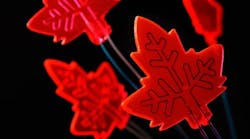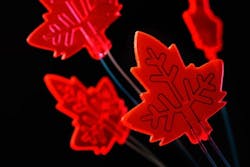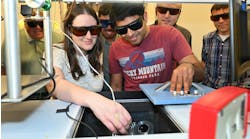Artificial Leaf Spurs Energy-Efficient Reactions
Drawing inspiration from photosynthesis performed in plants, a team of researchers from Eindhoven University of Technology, Eindhoven, The Netherlands, have developed a leaf-shaped microphotoreactor that uses solar energy to produce pharmaceuticals. The artificial leaf features luminescent solar concentrators with very thin channels. When liquid is pumped through the channels, the molecules are exposed to sunlight.
“This device based on fluorescent dye-doped polydimethylsiloxane collects sunlight, focuses the energy to a narrow wavelength region, and then transports that energy to embedded microchannels where the flowing reactants are converted,” report the researchers in an article in Angewandte Chemie International Edition.
It also can be fine-tuned by matching the emission of the microreactor with the absorption maximum of the photocatalyst flowing inside the reaction channels.
Figure 1. The amount of light captured by the microphotoreactors is visible, lit up bright red. As liquid is pumped through thin channels or “veins” in the leaves, light causes the reactions. Source: Bart van Overbeeke.
“In principle, every dye can be dissolved in the polymer to make a unique device. We are currently looking into this and we have some promising results,” notes lead researcher Timothy Noel.
The leaf, made from silicone rubber, can operate in diffuse light. “It can be easily cleaned with some solvent and subsequently reused,” says Noel.
“Theoretically, you could use this device to make drug compounds with solar energy anywhere you want,” he adds.
The next step is to further improve energy efficiency and increase output.
“We are now working on a Monte-Carlo ray-tracing model which completely explains the fate of photons hitting the device: i.e., where are these photons going to, how many of them hit the reaction channels, which are lost? This model is crucial to further improve the device. E.g. can we recuperate the photons that are lost, can we direct more of these photons to the channels?” explains Noel.
The researchers expect to finish the model this year. The device will likely become commercially viable and broadly available to chemical engineers within five to 10 years, they hope, but challenges remain.
“The throughput of a single device is quite low (grams per hour, depending on the reaction),” says Noel. “We are now working on a numbering up (placing many reactors in parrallel) strategy to increase the total throughput. However, it is particularly challenging to make sure the fluid flow is distributed evenly over the different channels. To minimize maldistribution, we have to make sure the pressure drop in the different channels is equal.” The researchers believe they’ll be able to address these issues this year as well.
“We hope to be able to make molecules from gram scale to several kg. This should be sufficient material for pharma. However, as long as you place enough channels in parallel, any scale is reachable. We are looking for suitable partners and funding to further exploit the potential of our artificial leaf. This is the first concept paper but we have many ideas for the future,” notes Noel.
The photomicroreactor could be tailored for many different photochemical or photocatalytic reactions. The idea is to build up entire molecules by using solar energy, say the researchers. While unable to elaborate more, Noel says they hope to make the required device to do this within two years.



